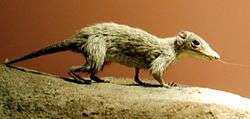Morganucodonta
| Morganucodonta Temporal range: Late Triassic – Lower Cretaceous 210–140 Ma | |
|---|---|
 | |
| Life restoration of a Megazostrodon, Natural History Museum, London | |
| Scientific classification | |
| Kingdom: | Animalia |
| Phylum: | Chordata |
| Clade: | Synapsida |
| Clade: | Mammaliformes |
| Order: | †Morganucodonta Kermack, Mussett & Rigney, 1973 |
| Subgroups | |
| |
Morganucodonta ("Glamorgan teeth") is an extinct order of primitive mammaliaformes similar to crown-group mammals. Their remains have been found in southern Africa, Western Europe, Arizona and China. The morganucodonts were most likely insectivorous and nocturnal, seeking prey while avoiding predators that were usually active by day. Such a trait may have been inherited by their descendants to avoid the predatory dinosaurs, though some of the latter were nocturnal as well.[1]
Anatomy

Morganucodonts were equipped with an unusual structure, the "double-joint", which meant that the jaw articulation would be made up of the dentary-squamosal joint as well as a quadrate-articular one. The articular and quadrate bones would eventually become the malleus and incus respectively. There is a trough at the back of the jaw that houses postdentary bones; such bones are absent today in mammals (all living mammals have a jaw that is composed of a single bone, one of the defining features of Mammalia).
Unlike Sinoconodon and the therapsids, morganucodont teeth were diphyodont (meaning that they possessed two sets of teeth as in all living mammals) and not polyphydont (meaning that the teeth are constantly replaced, as in reptiles). Furthermore, the primitive postcanine teeth have been replaced by true molars and premolars. The teeth are structured in such a way that occlusion happens by the lower cusp "a" fitting anteriorly to upper cusp "A", between "A" and "B". This occlusion pattern is also seen in the unrelated triconodontids, but it is by no means universal among morganucodonts; Dinnetherium, for example has an occlusion mechanism closer to that of gobiconodontids (also unrelated), in which molars basically alternate.[2] Wear facets are present.
The septomaxilla, a primitive feature also found in Sinoconodon, is found in morganucodonts, as well as a fully ossified orbitosphenoid. The anterior lamina is enlarged. The cranial moiety of the squamosal is a narrow bone that is superficially placed to the petrosal and parietal. Unlike its predecessors, the morganucodonts have a larger cerebral capacity and a longer cochlea.
The atlas elements are unfused; there is a suture between the dens and axis. The cervical ribs are not fused to the centra. The coracoid and procoracoid, which are absent in therians, are present. The head of the humerus is spherical as in mammals, but the spiral ulnar condyle is cynodont-like. In the pelvic girdle, the pubis, ilium and ischium are unfused. At least Megazostrodon and Erythrotherium are unique among mammaliformes for lacking epipubic bones, suggesting that they didn't have the same reproductive constraints.[3]
Classification
Because morganucodonts possessed the dentary-squamosal jaw joint, systematists like G. G. Simpson (1959)[4] considered the morganucodonts to be mammals, and most contemporary paleontologists continue to use this classification.[5] Others, however, limit Mammalia to the crown group and so exclude more basal mammaliaform orders like Morganucodonta.[6]
†Morganucodonta Kermack, Mussett & Rigney 1973 sensu Kielan-Jaworowska, Cifelli & Luo 2004[7][8]
- †Bridetherium dorisae Clemens 2011
- †Hallautherium schalchi Clemens 1980
- †Paceyodon davidi Clemens 2011
- †Purbeckodon batei Butler, Sigogneau-Russell & Ensom 2012
- †Rosierodon anceps Debuysschere, Gherrbrant & Allain 2014
- †Megazostrodontidae Cow 1986 sensu Kielan-Jaworowska, Cifelli & Luo 2004
- †Wareolestes rex Freeman 1979
- †Brachyzostrodon Sigogneau-Russell 1983a
- †B. coupatezi Sigogneau-Russell 1983a
- †B. molar Hahn, Sigogneau-Russell & Godefroit 1991
- †Megazostrodon Crompton & Jenkins 1968
- †M. rudnerae Crompton & Jenkins 1968
- †M. chenali Debuysschere, Gherrbrant & Allain 2014
- †Morganucodontidae Kühne 1958
- †Gondwanadon tapani Datta & Das 1996
- †Holwellconodon problematicus Lucas & Hunt 1990
- †Indozostrodon simpsoni Datta & Das 2001 sensu Prasad & Manhas 2002 [Indotherium Yadagiri 1984 non Kretzoi 1942; Indotherium pranhitai Yadagiri 1984]
- †Likhoeletherium Ellenberger 1970 (nomen nudum)
- †Helvetiodon schuetzi Clemens 1980 [Helveticodon Tatarinov 1985]
- †Erythrotherium parringtoni Crompton 1964
- †Eozostrodon parvus Parrington 1941 [Eozostrodon problematicus Parrington 1941; Morganucodon parvus (Parrington 1941)]
- †Morganucodon Kühne 1949
- †M. watsoni Kühne 1949 [Eozostrodon watsoni (Kühne 1949)]
- †M. oehleri Rigney 1963 [Eozostrodon oehleri (Rigney 1963)]
- †M. heikuopengensis (Young 1978) [Eozostrodon heikuopengensis Young 1978]
- †M. peyeri Clemens 1980 Eozostrodon peyeri (Clemens 1980)]
See also
References
- Notes
- ↑ Schmitz, Lars; Motani, Ryosuke (2011). "Nocturnality in dinosaurs inferred from scleral ring and orbit morphology". Science. 332: 705–708. doi:10.1126/science.1200043. PMID 21493820.
- ↑ Percy M. Butler; Denise Sigogneau-Russell (2016). "Diversity of triconodonts in the Middle Jurassic of Great Britain" (PDF). Palaeontologia Polonica 67: 35–65. doi:10.4202/pp.2016.67_035.
- ↑ Jason A. Lillegraven, Zofia Kielan-Jaworowska, William A. Clemens, Mesozoic Mammals: The First Two-Thirds of Mammalian History, University of California Press, 17/12/1979 - 321
- ↑ Simpson, George Gayord (1959). "Mesozoic mammals and the polyphyletic origin of mammals" (PDF). Evolution. 13 (3): 405–414. doi:10.2307/2406116.
- ↑ Kemp, T. S. (2005). The Origin and Evolution of Mammals. Oxford University Press. p. 3. ISBN 0198507607.
- ↑ Rowe, T. (1988). "Definition, diagnosis, and origin of Mammalia" (PDF). Journal of Vertebrate Paleontology. 8 (3): 241–264. doi:10.1080/02724634.1988.10011708.
- ↑ Mikko's Phylogeny Archive Haaramo, Mikko (2007). "Mammaliaformes – mammals and near-mammals". Retrieved 30 December 2015.
- ↑ Paleofile.com (net, info) . "Taxonomic lists- Mammals". Retrieved 30 December 2015.
- Bibliography
- Rich, PV; Fenton, MA; Fenton, CL; THV, Rich. The Fossil Book: A Record of Prehistoric Life. p. 519. ISBN 9780486293714.
- Palmer, D, ed. (2006). The Illustrated Encyclopedia of the Prehistoric World. Book Sales. p. 342. ISBN 9780785820864.
- Kielan-Jaworowska, Z; Luo, ZX; Cifelli, RL (2004). Mammals from the Age of Dinosaurs. Columbia University Press. pp. 168–183. ISBN 9780231119184.
External links
- "Mesozoic Mammals; Basal Mammaliaformes, Morganucodontidae, Megazostrodontidae and Hadrocodium, an internet directory". Karin and Trevor Dykes. Retrieved January 2013. Check date values in:
|access-date=(help)
